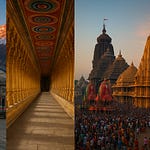Nestled at the base of the sacred Arunachala Hill in Tiruvannamalai, Tamil Nadu, the Arunachalesvara Temple, also known as Annamalaiyar Temple, is one of the most powerful spiritual centers in India. Dedicated to Lord Shiva, the temple represents the element of fire (Agni) and is one of the revered Pancha Bhoota Sthalams — five temples each representing one of the fundamental elements of creation.
📜 Origin & Mythological Legend
The temple's mythology stems from a divine episode where Lord Vishnu and Lord Brahma argued about who was superior. To humble their ego, Lord Shiva manifested as an infinite column of fire, challenging both gods to find the beginning or end of the flame. Vishnu descended into the earth and accepted defeat, while Brahma lied about seeing the top. As punishment for his dishonesty, Brahma was denied temple worship, while Vishnu was blessed. The place where Shiva appeared as the column of fire became Arunachala Hill, and the temple was built in reverence to this divine manifestation. It is believed that the hill itself is a form of Shiva, and the temple is a doorway to liberation.
🏛️ Historical Significance & Architectural Marvel
The origins of the temple date back to pre-Vedic times, with references in sacred texts like the Skanda Purana, Lingam Purana, and Arunachala Mahatmyam. The temple was significantly expanded during the Chola dynasty (9th to 13th century), when many gopurams (towers) and shrines were constructed. The Vijayanagara kings added grand pillared halls and the towering Eastern Gopuram, which rises to 66 meters, making it one of the tallest temple towers in India. Subsequent Nayak rulers further embellished the temple with intricate stonework, mandapams (halls), and temple tanks. Today, the temple sprawls over 25 acres and features massive walls, large courtyards, and several sanctums, all designed in exquisite Dravidian architecture.
🕉️ Spiritual Importance
The Arunachalesvara Temple holds an unshakable position in Shaivism due to its connection with Agni (Fire), the purifying force among the five elements. It is believed that praying here cleanses past karmas, burns impurities, and grants moksha (liberation). Great saints like Sri Ramana Maharshi recognized the hill itself as Shiva and lived at its base for decades, guiding seekers to self-realization. Performing Giri Pradakshina, the 14-kilometer barefoot walk around Arunachala Hill, especially on full moon nights, is considered immensely powerful and spiritually rewarding.
🙏 Devotional Significance
For millions of devotees, this temple is not just a destination but a spiritual journey. People from across India and the world come seeking health, peace, prosperity, marriage, children, and enlightenment. It is believed that even thinking about Arunachala can purify the mind. The practice of chanting “Arunachala Shiva, Arunachala Shiva” is said to invoke deep inner transformation. The full moon night attracts lakhs of pilgrims who walk the Giri Pradakshina path, absorbing the divine vibration of the sacred mountain.
🛐 Pujas, Rituals, and Darshan Experience
The temple conducts six daily pujas, starting with Ushathkalam around 5:30 AM and concluding with Ardha Jamam by 10:00 PM. Each puja includes rituals like abhishekam (holy bath of the Shiva Lingam), alankaram (decoration), naivedyam (food offerings), and deepa aradhana (aarti with lamps). The Kalasanthi, Uchikalam, and Sayarakshai pujas are particularly popular among devotees.
Special rituals include Rudrabhishekam, 108 Sangabhishekam, and Karthigai Deepam Mahotsavam, which marks the annual lighting of a giant flame atop Arunachala Hill in November–December. The flame symbolizes the Jyotirlinga form of Shiva and is visible for miles. During this festival, over three million people gather to witness the sacred fire and participate in deep spiritual celebrations.
Darshan options include general darshan, Ekanta darshan (early morning, limited), and VIP darshan (available through prior booking or donations). The sanctum of Lord Arunachalesvara houses a large Shiva Lingam, while the shrine of Unnamulai Amman, the consort of Shiva, lies nearby. Pilgrims often visit both for a complete spiritual experience.
🎇 Special Rituals
Karthigai Deepam: Giant fire lit atop the hill every November–December.
Abhishekam: With milk, honey, ghee, and water during special days.
Rudrabhishekam: Powerful purification ritual with Vedic chants.
108 Sangabhishekam: Offered on full moon days and Pradoshams.
🌟 Special Darshans
Ekantha Darshan: Available during early morning for limited devotees.
VIP Darshan: Available via online booking or temple counter.
Girivalam Darshan: Unique spiritual walk around the Arunachala Hill.
🕯️ Aarti and Devotional Practices
The main aartis are performed four times a day—morning around 6:00 AM, noon at 12:00 PM, evening at 6:00 PM, and night at 9:30 PM. The aarti is accompanied by Vedic chanting, temple music, and the vibrant energy of hundreds of devotees offering flowers and prayers.
Chanting sacred mantras is common practice. One of the most revered mantras associated with Shiva here is:
“Karpoora Gauram Karunavataram
Sansara Saram Bhujagendra Haram
Sadā Vasantam Hridayāravinde
Bhavam Bhavani Sahitam Namāmi”
Additionally, simply repeating the words:
“Arunachala Shiva, Arunachala Shiva”
is considered a powerful spiritual practice recommended by Sri Ramana Maharshi himself.
✈️ Travel Information and Tips
Reaching the temple is easy. The closest major airport is Chennai, located about 180 kilometers away. Another option is Pondicherry Airport, which is closer but with fewer connections. Tiruvannamalai is well-connected by train to cities like Chennai, Bangalore, Vellore, and Salem. Regular buses and taxis also operate from these cities.
Numerous hotels, lodges, guesthouses, and ashrams provide accommodation. The temple also runs its own guesthouses for pilgrims. Ashrams like Sri Ramana Ashram offer tranquil stays for spiritual seekers.
The best time to visit is from October to March, when the climate is pleasant. The Karthigai Deepam festival in November–December is the most spiritually potent time to visit. The summer months (March–June) can be very hot, and it is advised to plan accordingly.
📷 What to See and Do
Within the temple complex, you can explore the sanctum of Lord Arunachalesvara, the Unnamulai Amman shrine, the 1000-pillar hall, Deepa Mandapam, and the sacred temple tanks. The Eastern Gopuram, one of the tallest in South India, is a must-see marvel. Outside the temple, Sri Ramana Ashram, Virupaksha Cave, and Skanda Ashram are peaceful spiritual centers worth visiting.
Performing Giri Pradakshina is a highlight of every visit. The 14-kilometer circumambulation around Arunachala Hill can be done at any time but is especially powerful on full moon nights. Many do this barefoot as an act of devotion.
🌄 Nearby Attractions
Besides the temple, you can explore:
Sri Ramana Maharshi’s Samadhi and Ashram
Virupaksha Cave (where Ramana meditated)
Sathanur Dam
Yogi Ramsuratkumar Ashram
Parvati Hilltop Temple
Each place adds a unique layer to the spiritual depth of Tiruvannamalai.
The Arunachalesvara Temple is not just a structure of stone and scripture. It is a living energy center where time pauses, egos dissolve, and divinity is felt in every breath. The presence of Lord Shiva here is not just symbolic — it is tangible. Whether you're a seeker, a devotee, or a traveler, Arunachala embraces all with grace and silence.
“To know the Self is to know Arunachala.
To see Arunachala is to see the Self.”
— Sri Ramana Maharshi










